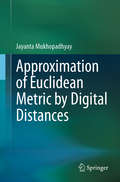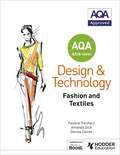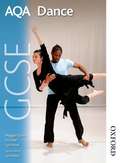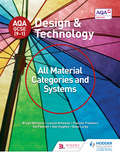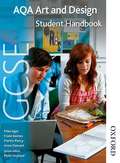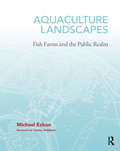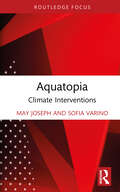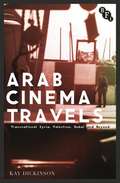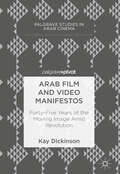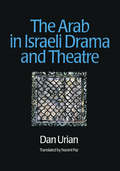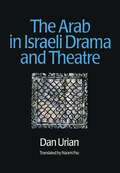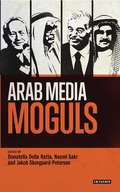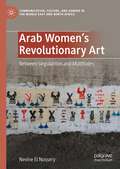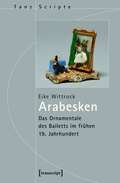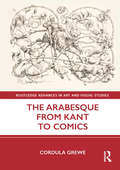- Table View
- List View
Approximation and Online Algorithms: 9th International Workshop, WAOA 2011, Saarbrücken, Germany, September 8-9, 2011, Revised Selected Papers (Lecture Notes in Computer Science #7164)
by Roberto Solis-Oba Giuseppe PersianoThis book constitutes the thoroughly refereed post-proceedings of the 9th International Workshop on Approximation and Online Algorithms, WAOA 2011, held in Saarbrücken, Germany, in September 2011. The 21 papers presented were carefully reviewed and selected from 48 submissions. The volume also contains an extended abstract of the invited talk of Prof. Klaus Jansen. The Workshop on Approximation and Online Algorithms focuses on the design and analysis of algorithms for online and computationally hard problems. Both kinds of problems have a large number of applications in a wide variety of fields. Topics of interest for WAOA 2011 were: algorithmic game theory, approximation classes, coloring and partitioning, competitive analysis, computational finance, cuts and connectivity, geometric problems, inapproximability results, mechanism design, network design, packing and covering, paradigms for design and analysis of approximation and online algorithms, parameterized complexity, randomization techniques and scheduling problems.
Approximation of Euclidean Metric by Digital Distances
by Jayanta MukhopadhyayThis book discusses different types of distance functions defined in an n-D integral space for their usefulness in approximating the Euclidean metric. It discusses the properties of these distance functions and presents various kinds of error analysis in approximating Euclidean metrics. It also presents a historical perspective on efforts and motivation for approximating Euclidean metrics by digital distances from the mid-sixties of the previous century. The book also contains an in-depth presentation of recent progress, and new research problems in this area.
Approximation, Randomization, and Combinatorial Optimization. Algorithms and Techniques: 14th International Workshop, APPROX 2011, and 15th International Workshop, RANDOM 2011, Princeton, NJ, USA, August 17-19, 2011, Proceedings (Lecture Notes in Computer Science #6845)
by Leslie Ann Goldberg Klaus Jansen R. Ravi José D. P. RolimThis book constitutes the joint refereed proceedings of the 14th International Workshop on Approximation Algorithms for Combinatorial Optimization Problems, APPROX 2011, and the 15th International Workshop on Randomization and Computation, RANDOM 2011, held in Princeton, New Jersey, USA, in August 2011. The volume presents 29 revised full papers of the APPROX 2011 workshop, selected from 66 submissions, and 29 revised full papers of the RANDOM 2011 workshop, selected from 64 submissions. They were carefully reviewed and selected for inclusion in the book. In addition two abstracts of invited talks are included. APPROX focuses on algorithmic and complexity issues surrounding the development of efficient approximate solutions to computationally difficult problems. RANDOM is concerned with applications of randomness to computational and combinatorial problems.
AQA AS/A-Level Design and Technology: Fashion and Textiles
by Pauline Treuherz Amanda Dick Denise DaviesEncourage your students to be creative, innovative and critical designers with a textbook that builds in-depth knowledge and understanding of the materials, components and processes associated with the creation of fashion and textile products.Our experienced author team will help guide you through the requirements of the specification, covering the core technical and designing and making principles needed for the 2017 AQA AS and A-level Design and Technology Fashion and Textiles specification.- Explores real-world contexts for fashion and textiles- Develops practical skills and theoretical knowledge and builds student confidence- Supports students with the application of maths skills to fashion and textiles- Helps guide students through the requirements of the Non-Exam Assessments and the written exams at both AS and A-level
AQA AS/A-Level Design and Technology: Fashion and Textiles
by Amanda Dick Pauline Treuherz Denise DaviesExam board: AQALevel: A-levelSubject: Design and TechnologyFirst teaching: September 2017First exams: Summer 2018 (AS) Summer 2019 (A-Level)Encourage your students to be creative, innovative and critical designers with a textbook that builds in-depth knowledge and understanding of the materials, components and processes associated with the creation of fashion and textile products.Our experienced author team will help guide you through the requirements of the specification, covering the core technical and designing and making principles needed for the 2017 AQA AS and A-level Design and Technology Fashion and Textiles specification.- Explores real-world contexts for fashion and textiles- Develops practical skills and theoretical knowledge and builds student confidence- Supports students with the application of maths skills to fashion and textiles- Helps guide students through the requirements of the Non-Exam Assessments and the written exams at both AS and A-level
AQA Dance GCSE: Student Book (PDF)
by Paine Lyn Clunie Maggie Dale LizThis resource has been developed with and exclusively endorsed by AQA. With a real focus on tracking individual progress, you can improve your chance of exam success through a unique blend of print and electronic resources.
AQA GCSE: All Material Categories And Systems Ebook (AQA GCSE (9-1) Design and Technology (PDF))
by Bryan Williams Louise Attwood Pauline Treuherz Dave Larby Ian Fawcett Dan HughesBuild in-depth understanding and inspire your students to tackle design challenges both practically and creatively, with a textbook that delivers the Core Technical plus Specialist Technical and Design & Making Principles needed for the 2017 AQA D&T GCSE.The insight of our author team will build topic knowledge, including the technical principles of materials with which you are less familiar, to ensure you can navigate the specification with confidence whilst your students' ideas flourish.· Trusted author team of specialist teachers and those with examining experience· Build topic knowledge with learning objectives directly linked to the specification and short activities to reinforce understanding· Develop mathematical and scientific knowledge and understanding with activities that link topics to maths and science· Inspire your students as they undertake the iterative design process, with examples of imaginative design-and-make tasks, and a look at how to approach the Non-Exam Assessment· Check knowledge and understanding with end of topic summaries and practice questions for the written exam
AQA GCSE Art and Design: Student Handbook
by Frank Barnes Anne Stewart Mike Ager Martin PiercyThe AQA GCSE Art amp; Design resources unpack the assessment criteria through exemplar material from students and artists, enabling students of all endorsements to achieve their creative potential.
AQA GCSE Art and Design: Student Handbook (PDF)
by Frank Barnes Anne Stewart Mike Ager Martin PiercyThe AQA GCSE Art amp; Design resources unpack the assessment criteria through exemplar material from students and artists, enabling students of all endorsements to achieve their creative potential.
Aquaculture Landscapes: Fish Farms and the Public Realm
by Michael EzbanAquaculture Landscapes explores the landscape architecture of farms, reefs, parks, and cities that are designed to entwine the lives of fish and humans. In the twenty-first century, aquaculture’s contribution to the supply of fish for human consumption exceeds that of wild-caught fish for the first time in history. Aquaculture has emerged as the fastest growing food production sector in the world, but aquaculture has agency beyond simply converting fish to food. Aquaculture Landscapes recovers aquaculture as a practice with a deep history of constructing extraordinary landscapes. These landscapes are characterized and enriched by multispecies interdependency, performative ecologies, collaborative practices, and aesthetic experiences between humans and fish. Aquaculture Landscapes presents over thirty contemporary and historical landscapes, spanning six continents, with incisive diagrams and vivid photographs. Within this expansive scope is a focus on urban aquaculture projects by leading designers—including Turenscape, James Corner Field Operations, and SCAPE—that employ mutually beneficial strategies for fish and humans to address urban coastal resiliency, wastewater management, and other contemporary urban challenges. Michael Ezban delivers a compelling account of the coalitions of fish and humans that shape the form, function, and identity of cities, and he offers a forward-thinking theorization of landscape as the preeminent medium for the design of ichthyological urbanism in the Anthropocene. With over two hundred evocative images, including ninety original drawings by the author, Aquaculture Landscapes is a richly illustrated portrayal of aquaculture seen through the disciplinary lens of landscape architecture. As the first book devoted to this topic, Aquaculture Landscapes is an original and essential resource for landscape architects, urbanists, animal geographers, aquaculturists, and all who seek and value multispecies cohabitation of a shared public realm.
Aquaculture Landscapes: Fish Farms and the Public Realm
by Michael EzbanAquaculture Landscapes explores the landscape architecture of farms, reefs, parks, and cities that are designed to entwine the lives of fish and humans. In the twenty-first century, aquaculture’s contribution to the supply of fish for human consumption exceeds that of wild-caught fish for the first time in history. Aquaculture has emerged as the fastest growing food production sector in the world, but aquaculture has agency beyond simply converting fish to food. Aquaculture Landscapes recovers aquaculture as a practice with a deep history of constructing extraordinary landscapes. These landscapes are characterized and enriched by multispecies interdependency, performative ecologies, collaborative practices, and aesthetic experiences between humans and fish. Aquaculture Landscapes presents over thirty contemporary and historical landscapes, spanning six continents, with incisive diagrams and vivid photographs. Within this expansive scope is a focus on urban aquaculture projects by leading designers—including Turenscape, James Corner Field Operations, and SCAPE—that employ mutually beneficial strategies for fish and humans to address urban coastal resiliency, wastewater management, and other contemporary urban challenges. Michael Ezban delivers a compelling account of the coalitions of fish and humans that shape the form, function, and identity of cities, and he offers a forward-thinking theorization of landscape as the preeminent medium for the design of ichthyological urbanism in the Anthropocene. With over two hundred evocative images, including ninety original drawings by the author, Aquaculture Landscapes is a richly illustrated portrayal of aquaculture seen through the disciplinary lens of landscape architecture. As the first book devoted to this topic, Aquaculture Landscapes is an original and essential resource for landscape architects, urbanists, animal geographers, aquaculturists, and all who seek and value multispecies cohabitation of a shared public realm.
Aquatopia: Climate Interventions (Critical Climate Studies)
by May Joseph Sofia VarinoAquatopia documents Harmattan Theater’s ecological interventions and traces its engagements with water-bound landscapes, colonial histories, climate change, and public space across New York City, Venice, Amsterdam, Lisbon, and Cochin. The volume uses Harmattan’s site-specific performances as a point of departure to consider climate change and rising sea levels as geographical, ecological, and urban phenomena. Instead of a collection of flat, static surfaces, the Aquatopia atlas is animated by a disorienting, anti-mapping strategy, producing a deterritorialized, nomadic, fluid atlas unfolding in real time as an archive of climate change in multidimensional, active space. The book is designed for pedagogical access, with interludes that consolidate the learning outcomes of the experimental theory animating each site-specific performance. Accompanied by close descriptions of five performances and supplemented by digital documentation available online, this volume intervenes in discussions on climate change, urbanism, and postcolonization/decolonialization, and contributes to interdisciplinary studies of ecology and environmental politics, postcolonial/decolonial theories and practices, performance studies and aesthetics, in particular public art, and performance as research.
Aquatopia: Climate Interventions (Critical Climate Studies)
by May Joseph Sofia VarinoAquatopia documents Harmattan Theater’s ecological interventions and traces its engagements with water-bound landscapes, colonial histories, climate change, and public space across New York City, Venice, Amsterdam, Lisbon, and Cochin. The volume uses Harmattan’s site-specific performances as a point of departure to consider climate change and rising sea levels as geographical, ecological, and urban phenomena. Instead of a collection of flat, static surfaces, the Aquatopia atlas is animated by a disorienting, anti-mapping strategy, producing a deterritorialized, nomadic, fluid atlas unfolding in real time as an archive of climate change in multidimensional, active space. The book is designed for pedagogical access, with interludes that consolidate the learning outcomes of the experimental theory animating each site-specific performance. Accompanied by close descriptions of five performances and supplemented by digital documentation available online, this volume intervenes in discussions on climate change, urbanism, and postcolonization/decolonialization, and contributes to interdisciplinary studies of ecology and environmental politics, postcolonial/decolonial theories and practices, performance studies and aesthetics, in particular public art, and performance as research.
Arab Cinema Travels: Transnational Syria, Palestine, Dubai and Beyond (Cultural Histories of Cinema)
by Kay DickinsonExploring the impact of travel on Arab cinema, Kay Dickinson reveals how the cinemas of Syria, Palestine and Dubai have been shaped by the history and politics of international circulation. This compelling book offers fresh insights into film, mobility and the Middle East.
Arab Cinema Travels: Transnational Syria, Palestine, Dubai and Beyond (Cultural Histories of Cinema)
by Kay DickinsonExploring the impact of travel on Arab cinema, Kay Dickinson reveals how the cinemas of Syria, Palestine and Dubai have been shaped by the history and politics of international circulation. This compelling book offers fresh insights into film, mobility and the Middle East.
Arab Film and Video Manifestos: Forty-Five Years of the Moving Image Amid Revolution (Palgrave Studies in Arab Cinema)
by Kay DickinsonArab Film and Video Manifestos presents, in their entirety, five key documents that have fundamentally shaken up and helped change the face of image culture in the Middle East and beyond. The book collects together, for the first time, these influential, collectively written calls and directives that span a fifty-year period and hail from a range of different countries. Each urges a radical rethinking of film and video’s role in culture, its relation to politics, and its potential to instigate profound change. Kay Dickinson carefully positions the manifestos within their broader socio-historical contexts and provides supplementary reading and viewing suggestions for readers who cannot access Arabic-language sources.
The Arab Imago: A Social History of Portrait Photography, 1860–1910
by Stephen SheehiThe first history of indigenous photography in the Middle EastThe birth of photography coincided with the expansion of European imperialism in the Middle East, and some of the medium's earliest images are Orientalist pictures taken by Europeans in such places as Cairo and Jerusalem—photographs that have long shaped and distorted the Western visual imagination of the region. But the Middle East had many of its own photographers, collectors, and patrons. In this book, Stephen Sheehi presents a groundbreaking new account of early photography in the Arab world.The Arab Imago concentrates primarily on studio portraits by Arab and Armenian photographers in the late Ottoman Empire. Examining previously known studios such as Abdullah Frères, Pascal Sébah, Garabed Krikorian, and Khalil Raad, the book also provides the first account of other pioneers such as Georges and Louis Saboungi, the Kova Brothers, Muhammad Sadiq Bey, and Ibrahim Rif'at Pasha—as well as the first detailed look at early photographs of the annual pilgrimage to Mecca. In addition, the book explores indigenous photography manuals and albums, newspapers, scientific journals, and fiction.Featuring extensive previously unpublished images, The Arab Imago shows how native photography played an essential role in the creation of modern Arab societies in Egypt, Palestine, Syria, and Lebanon before the First World War. At the same time, the book overturns Eurocentric and Orientalist understandings of indigenous photography and challenges previous histories of the medium.
The Arab in Israeli Drama and Theatre
by Dan UrianWhat is Israeli theatre? Is it only a Hebrew theatre staged in Israel? Are performances by Arab Israelis working in an Arabic theatre framework not part of the repertoire of Israeli theatre? Do they perhaps belong to the Palestinian theatre? What are the "borders" of Palestinian theatre? Are not theatrical works created in East Jerusalem by Arab Israeli playwrights and actors, and staged on occasion before Jewish Israeli audiences, part of a dialogue between Palestinian and Israeli cultures? Does "theatre" only include works staged under that title? These and other similarly absorbing questions arise in Dan Urian's wide-ranging and detailed study of the image of the Arab in Israeli drama and theatre. By the use of extensive examples to show how theatre, politics and personal perceptions intertwine, the author presents us with a model which can be used as a basis for the further discussion and study of similar social and artistic phenomena in other cultures in relation to their theatre and drama.
The Arab in Israeli Drama and Theatre (Contemporary Theatre Studies #Vol. 26)
by Dan UrianWhat is Israeli theatre? Is it only a Hebrew theatre staged in Israel? Are performances by Arab Israelis working in an Arabic theatre framework not part of the repertoire of Israeli theatre? Do they perhaps belong to the Palestinian theatre? What are the "borders" of Palestinian theatre? Are not theatrical works created in East Jerusalem by Arab Israeli playwrights and actors, and staged on occasion before Jewish Israeli audiences, part of a dialogue between Palestinian and Israeli cultures? Does "theatre" only include works staged under that title? These and other similarly absorbing questions arise in Dan Urian's wide-ranging and detailed study of the image of the Arab in Israeli drama and theatre. By the use of extensive examples to show how theatre, politics and personal perceptions intertwine, the author presents us with a model which can be used as a basis for the further discussion and study of similar social and artistic phenomena in other cultures in relation to their theatre and drama.
Arab Media Moguls: Community, Legitimacy And Public Life (Library Of Modern Middle East Studies)
by Naomi SakrPeople are on the move across the Arab world, organizing politically in new ways. The Arab media have also undergone a transformation and are still in a state of flux. It is therefore crucial to be able to discuss political initiatives in the region in the light of media developments. This authoritative book answers key questions about the connections between media and political change in the Arab world. Using research into, for example, practices of Internet users, journalists, demonstratorsand producers of reality TV, it explores the interface between public interaction over the airwaves, at the polls and on the streets. A lively group of contributors explores such issues as whether young people are served well by new media, whether blogging is an influential political tool, whether satellite news helps or hinders diasporic communities politically, and much more. Engaging with debates at the heart of public affairs and popular culture in Arab countries, this book addresses everyone who seeks to grasp the media politics of this central, often misunderstood region.
Arab Women's Revolutionary Art: Between Singularities and Multitudes (Communication, Culture, and Gender in the Middle East and North Africa)
by Nevine El NosseryThis book examines the ways in which women in the contemporary Middle East and North Africa have re-imagined revolutionary discourses through creativity and collective action as a means of resistance. Encompassing a stunning array of forms and genres, such as graffiti, street performance, photography, phototexts, novels, and comics, the book draws from a vast spectrum of artistic production in revolutionary periods between 2011 and 2022 in Egypt, Tunisia, Morocco, and Algeria. El Nossery sheds light on women’s postrevolutionary artistic output by engaging an interdisciplinary approach: the book is divided into three sections which foreground the unique relationship between textual, visual, and performative modes as they intertwine with art and politics. Arab Women’s Revolutionary Art thereby aims to demonstrate how art, as always oriented towards an open future, can preserve the revolutionary spirit that was sparked in 2011 by documenting what happened and determining which stories would be told. The revolution, therefore, continues.
Arabesken - Das Ornamentale des Balletts im frühen 19. Jahrhundert (TanzScripte #35)
by Eike WittrockDie Arabeske ist nicht nur eine der wichtigsten Positionen des klassischen Ballettvokabulars, mit ihr lässt sich auch das Ornamentale des Balletts im frühen 19. Jahrhundert beschreiben. Aus größtenteils bisher unveröffentlichten ikonografischen Quellen entwickelt Eike Wittrock eine Ästhetik des Balletts, die sowohl die Einzelfigur Arabeske wie auch die Gruppenformationen des corps de ballet erfasst. Lithografien, choreografische Notationen, Abbildungen in Traktaten von Carlo Blasis und Léopold Adice, Musterbücher und Buchverzierungen werden dabei als historiografische Medien von Tanz verstanden, die die fantastische Bildlichkeit von Balletten wie »Giselle«, »Ondine« und »Thea, oder: Die Blumenfee« in der Aufzeichnung weiterführen.
The Arabesque from Kant to Comics (Routledge Advances in Art and Visual Studies)
by Cordula GreweThe Arabesque from Kant to Comics tracks the life and afterlife of the arabesque in its surprising transformation from an iconoclastic literary theory of early German Romanticism to aesthetic experimentation in both avant-garde art and popular culture. Its explosive growth in popularity was followed by an inevitable taming as arabesques became staples in book illustration, poetry publications, and even the decoration of printed scores. The subversive potential of the arabesque was preserved in one of its most surprising offspring, the comic strip: born at the moment when the cholera pandemic first swept through Europe, the comic translated the arabesque’s rank growth into unnerving lawlessness and sequences of contagious visual slapstick. Focusing roughly on the period between 1780 and 1880, this book illuminates the intersecting histories of avant-garde theories of writing, visual culture, and even the disciplinary origins of art history. In the process, it explores media history and intermediality, social networks and cultural transfer, as well as the rise of new and nontraditional art forms. This book will be of particular interest to scholars of art history, intellectual history, European art, aesthetics, book illustration, material culture, reproduction, comics, and German history.
The Arabesque from Kant to Comics (Routledge Advances in Art and Visual Studies)
by Cordula GreweThe Arabesque from Kant to Comics tracks the life and afterlife of the arabesque in its surprising transformation from an iconoclastic literary theory of early German Romanticism to aesthetic experimentation in both avant-garde art and popular culture. Its explosive growth in popularity was followed by an inevitable taming as arabesques became staples in book illustration, poetry publications, and even the decoration of printed scores. The subversive potential of the arabesque was preserved in one of its most surprising offspring, the comic strip: born at the moment when the cholera pandemic first swept through Europe, the comic translated the arabesque’s rank growth into unnerving lawlessness and sequences of contagious visual slapstick. Focusing roughly on the period between 1780 and 1880, this book illuminates the intersecting histories of avant-garde theories of writing, visual culture, and even the disciplinary origins of art history. In the process, it explores media history and intermediality, social networks and cultural transfer, as well as the rise of new and nontraditional art forms. This book will be of particular interest to scholars of art history, intellectual history, European art, aesthetics, book illustration, material culture, reproduction, comics, and German history.
Arabesque without End: Across Music and the Arts, from Faust to Shahrazad (Music and Visual Culture)
by Anne LeonardFeaturing multidisciplinary research by an international team of leading scholars, this volume addresses the contested aspects of arabesque while exploring its penchant for crossing artistic and cultural boundaries to create new forms. Enthusiastically imported from its Near Eastern sources by European artists, the freely flowing line known as arabesque is a recognizable motif across the arts of painting, music, dance, and literature. From the German Romantics to the Art Nouveau artists, and from Debussy’s compositions to the serpentine choreographies of Loïe Fuller, the chapters in this volume bring together cross-disciplinary perspectives to understand the arabesque across both art historical and musicological discourses.

